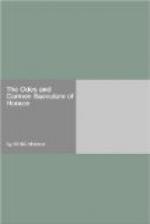periods of English poetry, and so be independent of
any. Such a metre is that which I have been led
to choose, the eight-syllable iambic with alternate
rhymes. It is one of the commonest metres in the
language, and for that reason it is adapted to more
than one class of subjects, to the gay as well as
to the grave. But I am mistaken if it is not
peculiarly suited to express that concentrated grandeur,
that majestic combination of high eloquence with high
poetry, which make the early Alcaic Odes of Horace’s
Third Book what they are to us. The main difficulty
is in accommodating its structure to that of the Latin,
of varying the pauses, and of linking stanza to stanza.
It is a difficulty before which I have felt myself
almost powerless, and I have in consequence been driven
to the natural expedient of weakness, compromise,
sometimes evading it, sometimes coping with it unsuccessfully.
In other respects I may be allowed to say that I have
found the metre pleasanter to handle than any of the
others that I have attempted, except, perhaps, that
of “The Dream of Fair Women.” The
proportion of syllables in each stanza of English to
each stanza of Latin is not much greater than in the
case of the Sapphic, thirty-two against forty-one;
yet, except in a few passages, chiefly those containing
proper names, I have had no disagreeable sense of
confinement. I believe the reason of this to be
that the Latin Alcaic generally contains fewer words
in proportion than the Latin Sapphic, the former being
favourable to long words, the latter to short ones,
as may be seen by contrasting such lines as “Dissentientis
conditionibus” with such as “Dona praesentis
rape laetus horae ac.” This, no doubt,
shows that there is an inconvenience in applying the
same English iambic measure to two metres which differ
so greatly in their practical result; but so far as
I can see at present, the evil appears to be one of
those which it is wiser to submit to than to attempt
to cure.
The problem of finding English representatives for
the other Horatian metres, if a more difficult, is
a less important one. The most pressing case
is that of the metre known as the second Asclepiad,
the “Sic te diva potens Cypri.” With
this, I fear, I shall be thought to have dealt rather
capriciously, having rendered it by four different
measures, three of them, however, varieties of the
same general type. It so happens that the first
Ode which I translated was the celebrated Amoebean
Poem, the dialogue between Horace and Lydia. I
had had at that time not the most distant notion of
translating the whole of the Odes, or even any considerable
number of them, so that in choosing a metre I thought
simply of the requirements of the Ode in question,
not of those of the rest of its class. Indeed,
I may say that it was the thought of the metre which
led me to try if I could translate the Ode. Having
accomplished my attempt, I turned to another Ode of
the same class, the scarcely less celebrated “Quem




